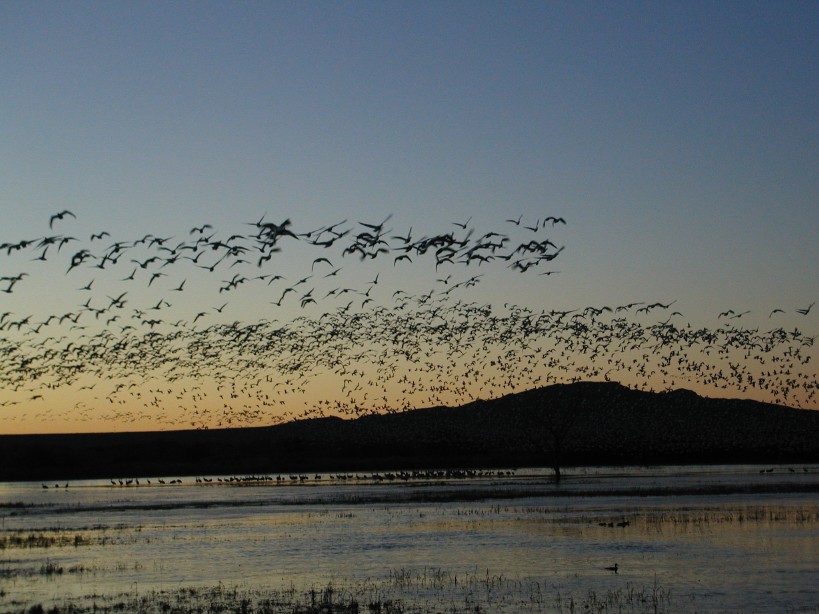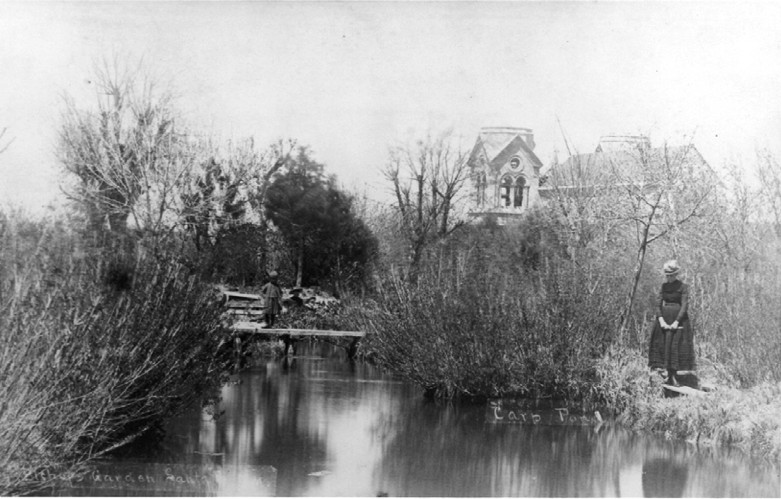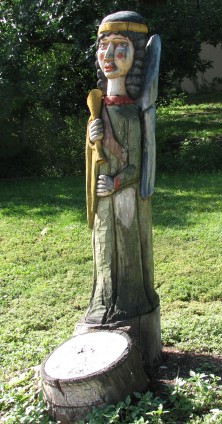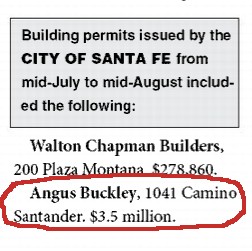

copyright 2006 by George Johnson

Bosque del Apache. photo by Nancy Maret, copyright 2006
1. Retrofit Arithmetic (and Rainbarrel Economics)
2. The San Juan-Chama Shell Game
3. The Case of the Disappearing Aquifer
4. The Creative Hydrology of Suerte del Sur
5. The City, the County, and a Water Tax Revolt
6. Water Numerology at City Hall
(Our story thus far)
7. The Woman at Otowi Gauge
8. "Forget it, Jake. It's Chinatown."
9. The Las Campanas Connection . . . desalination word games . . . and Aamodt South
(Our story continues)
10. The Engineering Solution
11. The Sorrows of San Acacio
12. The City's Dubious Water Report
13. Where the Water Went
14. Shutting Down the River Again
15. Picking on the Davises
16. The Tom Ford Webcam
17. Galen Buller's Day Off
18. Forgive and Forget
19. Election Postmortem
20. El Molino Gigante
21. Hotel Santa Fe. . . Mansion Watch . . . Water Watch
(Our story continues)
22. The Environmental Impact of Jennifer Jenkins
23. The Short-term Rental Racket . . . Water Watch . . . Mansion Watch . . . Surreal Estate
24. Archbishop Lamy's Parking Lot
25. Mayor Coss's Lost Gamble
26. Tommy Macione Swamp
27. Sweeney Center Blues
28. The Tragedy of the Commoners
29. Councilors, Cops, and Russian Dolls
30. West Side Story
31. Taking Back the River
August 21, 2006
31. Taking Back the River
Early last summer after a bounteous snow melt filled the reservoirs and water poured down the Santa Fe River, bringing kayakers and trout fishermen to the middle of town, the Water Division was asked to study the feasibility of guaranteeing a minimal flow throughout the summer and fall. Impossible, the water czars concluded. Maintaining a running river would require an acre-foot per mile per day, or two cubic feet per second. Reaching as far west as, say, St. Francis Drive would mean releasing 484 acre-feet over a four-month period -- 12 percent of the reservoirs' capacity, enough to provide precisely 3,227 people with drinking water. Everyone, including the council and the newspapers, let the matter drop.

The Water Division's analysis was little more than an exercise in spreadsheet propaganda. Of course 3,227 people would not be denied hydration. The wells might have to be pumped a little harder until the Rio Grande Diversion came on line -- regrettable but not nearly so bad as letting hundred-year-old cottonwoods die or risking a bosque fire in a canyon with just one way out. Even more disingenuous was the notion that the 484 acre-feet amounted to "lost water." Some of it, depending on the porosity of the soil, would seep into the ground recharging the very aquifer tapped by the city well field. We would be taking the same water through a different straw.
Finally, the report overlooked the fact that as water flowed out of the reservoirs, more would be flowing in. Whenever McClure and Nichols fill to the brim, the surplus must be discharged -- in one erosional swoosh. Some of the modest portion of water allowed to bypass the dams would be water that would have to be released anyway.
But that wasn't what the Delgado Administration and its allies wanted to hear. Councilor Ortiz said he could see no "tangible sense" in using publicly owned water for "aesthetic" purposes. (The river doesn't flow through his district.) Instead we were offered once again a pie-in-the-sky plan to pump effluent 12 miles and a thousand feet uphill from the sewage treatment plant on Airport Road to the top of Canyon Road and let it run back down.
No one seriously believes that will happen, and not just because of soaring energy and construction costs. Treated effluent has become a commodity. The city uses it to irrigate parks and other public land. It sells it to Las Campanas for its golf course and to construction companies for controlling dust and mixing concrete. There is only so much to go around. The cheaper, more efficient way to give water back to the river would be to let a small amount flow past the reservoirs all of the time.
During this Venusian summer, as much as 30 to 46 acre feet a day have been funneling in from the watershed. Letting go of just a fraction of that -- 4 acre feet -- is all it would take to restore a shallow flow through downtown. Double the amount and the water might reach Frenchy's Field.
Even in drier times -- especially in drier times -- the city's water budget should include a line item for the river: of the inflow measured at the McClure gauge, a specified percentage would be released downstream. The reservoirs, now at 83 percent and rising, would fill a little more slowly, but what a small price to pay for having our river back again.
August 23, 2006
Update
Staci Matlock reports in today's New Mexican that the inflow into McClure reached 20 million gallons on Monday and that 70 percent of Santa Fe's water is currently coming from the reservoirs rather than the wells.
Despite this windfall, Elephant Butte in southern New Mexico is up to only 300,000 acre-feet, 15 percent of its capacity. Until the level reaches 400,000, McClure and Nichols are barred, under the Rio Grande Compact (pdf download), from storing any water. To get around that inconvenience, the city has been dumping a compensating amount of its San Juan-Chama water from Lake Heron for delivery into the Rio Grande.
Why not release the same amount instead from Nichols into the Santa Fe River? Without going into details, a short piece in Monday's Journal reported that city water officials are "rethinking" how to manage Santa Fe's water supply. We can only hope that this is one of the options.


chainsaw sculpted cottonwood
on the Alameda
August 25, 2006
The newspapers reported yesterday that inflow into McClure reached an astounding 43 million gallons on Tuesday -- 132 acre feet, as much water as the entire city uses in three or four days. With the two reservoirs nearly full, the Water Division is finally planning a release into the Santa Fe River. Welcome as the decision is, it does not represent a change in management strategy. It is simply impossible to store another drop. In one great rush a torrent will come that, in hindsight, could have been gradually released throughout the summer.
No one could have predicted this off-the-scale monsoon season. But now that Mother Nature has forced the city's hand, there is an opportunity to develop a better water plan, one that would recognize that water returned to the river is not discarded, that would guarantee that whenever there is a flow coming into the reservoirs that there is a smaller one coming out.
Last year a visiting travel writer walking along the Alameda mistook the Santa Fe River for a nameless arroyo. It was an understandable mistake. "Alameda" comes from the Spanish word for cottonwood. As the aquifer, denied replenishment, continues to recede the species is steadily dying off.

August 26, 2006
A deadline for an article I was writing kept me inside yesterday, so this morning when there was a break in the clouds I walked to Patrick Smith Park and then down the river to the waterfall near Camino Escondido. A light rain, almost as delicate as a mist, reacted with sunlight to produce a rare Santa Fe phenomenon -- a rainbow in the west at 8 o'clock in the morning.
The water began pouring out of Nichols Thursday night, today's New Mexican tells us, and it's a wonderful sound. Pink noise, the acoustic engineers call it -- a little softer than white noise, more soothing than any anxiolytic drug. At 30 cubic feet per second this morning's flow is 15 times the threshold that would be required to sustain a stream year round through downtown.
How lucky it would have been to be standing on, say, the Palace Avenue bridge when the floodgates were opened, surprised by the soft roar of approaching water, coming from the distance like a train.

Davis mansion. August 25, 2006
September 12, 2006
Catching up on the news
It was too good to last. This morning, just three days after the city sponsored a Fishing Fiesta along the Alameda, it has decided to turn the river off again. A brief in this morning's New Mexican says that as of Monday the spillways will be closed to allow for reconstruction of the Camino Alire Bridge. That may not mark the end of this year's flows. The paper also reports that the Water Division plans to keep the reservoirs no fuller than 90 percent to allow for the possibility of more rain. If the monsoons resume or we get our usual mid-October squalls, more water may have to be released. And so continues the boom and bust cycles that come from having no real river plan.

On the southern flank, the cranes and backhoes are expected to appear any day now at the Tom Ford mansion site atop the old reservoir hill. This item appeared in Sunday's real estate magazine:

Buckley is the surname of Mr. Ford's partner, Richard Buckley, and Angus is their fox terrier.

In anticipation of more spectators to the Tom Ford Webcam, I have added a band of Google advertisements to the bottom of the page. It looks pretty tacky. The ads are chosen automatically by Google's computers and have consisted mostly of solicitations for Santa Fe real estate and Tom Ford sunglasses. Any earnings (total so far: $1.87) will be used to pay for some Santa Fe Review advertisements in the local papers.

More on the Rental Racket
Last week, having already sat down to coffee with builders and business owners, Mayor Coss finally got around to the neighborhoods. The latest of his "Coffees With Coss" was aimed at Santa Feans whose main concern is not how much money they can squeeze from real estate deals -- rezonings, lot splits, infill development, illicit b&b's -- but who just want this to be a better place to work and live. Appropriately enough, the gathering was held at the troubled Genoveva Chavez Community Center, which has become a symbol of the problems Mr. Coss has inherited from the Jaramillo and Delgado administrations.
As we've learned in recent newspaper reports, maintenance and structural problems have saddled the six-year-old recreation complex, designed by City Manager Asenath Kepler's husband, Ed Mazria, with a potential repair bill of some $1 million. Sitting beneath its leaky, pigeon-infested roof, some 50 citizens complained about other legacies of neglect: uncontrolled traffic, backed-up sewers, and (the Journal reported) illegal vacation rentals.
The Short-Term Rental Task Force's recommendations for legitimizing the practice -- written largely by Management Group owner Janet Reed Rousselot and circulated among industry insiders for approval -- were presented earlier this month at a meeting of the Public Works Committee. (For background on the issue, please see Parts 21 and 23.) While a previous hearing was stacked with maids and gardeners, this time Ms. Rousselot and her colleagues rounded up some of their customers, including (also from the Journal) a man from Cincinnati who said he and his wife spend some $20,000 a week when they visit here. "My wife does wonders for your economy," he said. We're supposed to think that they would stop coming to Santa Fe if forced to stay at La Fonda or another of the many licensed hotels.

Coming Soon: The Battle for Talaya Hill
The Andrew and Sydney Davis Webcam
Santa Fe Review Detours of the Wild West
The Santa Fe Review

More links:
See the current flow of the Santa Fe River above McClure Reservoir with the USGS automated gauge.
The Otowi gauge shows the flow of the Rio Grande north of Santa Fe.
Santa Fe water information, a collection of documents and links